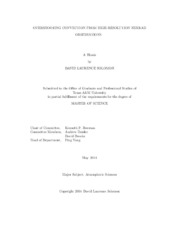| dc.description.abstract | Convection can rapidly and irreversibly transport tropospheric air into the upper
troposphere and, in some cases, through the tropopause into the lower stratosphere.
Previous studies have shown that stratosphere-troposphere exchange of any kind
can have a significant impact on the composition of the upper troposphere and lower
stratosphere. This will in turn affect the climate, chemistry, and radiation budget
of the atmosphere. Large scale transport events such as Rossby wave breaking,
the Brewer-Dobson circulation, and tropopause folding have been well studied, but
smaller-scale processes are less well understood. In order to understand the importance
of convective transport on the composition of the lower stratosphere, it is
necessary to know the frequency, magnitude, and location of overshooting convection
events. A new method that combines radar reflectivities from individual radars into
a three-dimensional composite with high vertical resolution is used to obtain storm
top altitudes. These altitudes are compared to the lapse-rate tropopause height calculated
using the ERA-Interim reanalysis to determine if a storm is overshooting.
We compute a 1-year analysis of overshooting convection at three-hour intervals for
2004 for the continental U.S. east of the Rocky Mountains. Overshooting convection
is most common over the high plains, and there is a pronounced seasonal and
diurnal cycle present. The majority of overshooting systems occur during the warm
season, and a diurnal maximum of overshooting occurs at 00 UTC. Analyzing the
total volume of tropopause penetrating storms reveals that the largest amount of
overshooting penetrates less than 1 km above the tropopause, and that the volume
of overshooting drops off rapidly with increasing height above the tropopause. | en |


